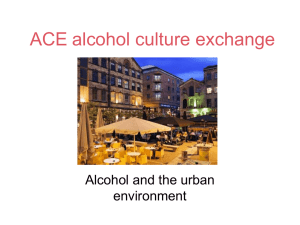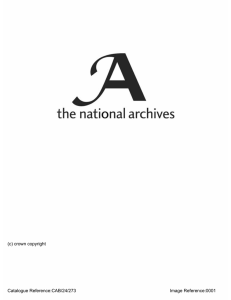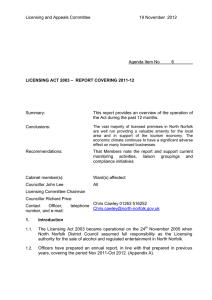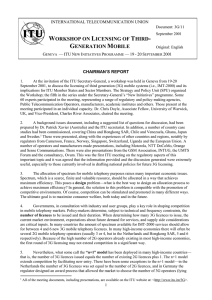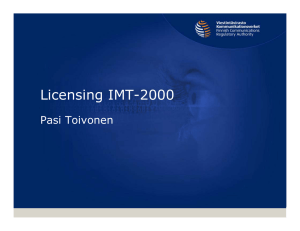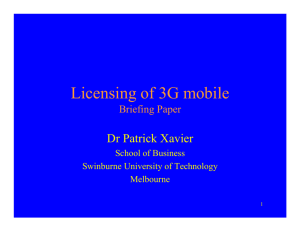W L T
advertisement
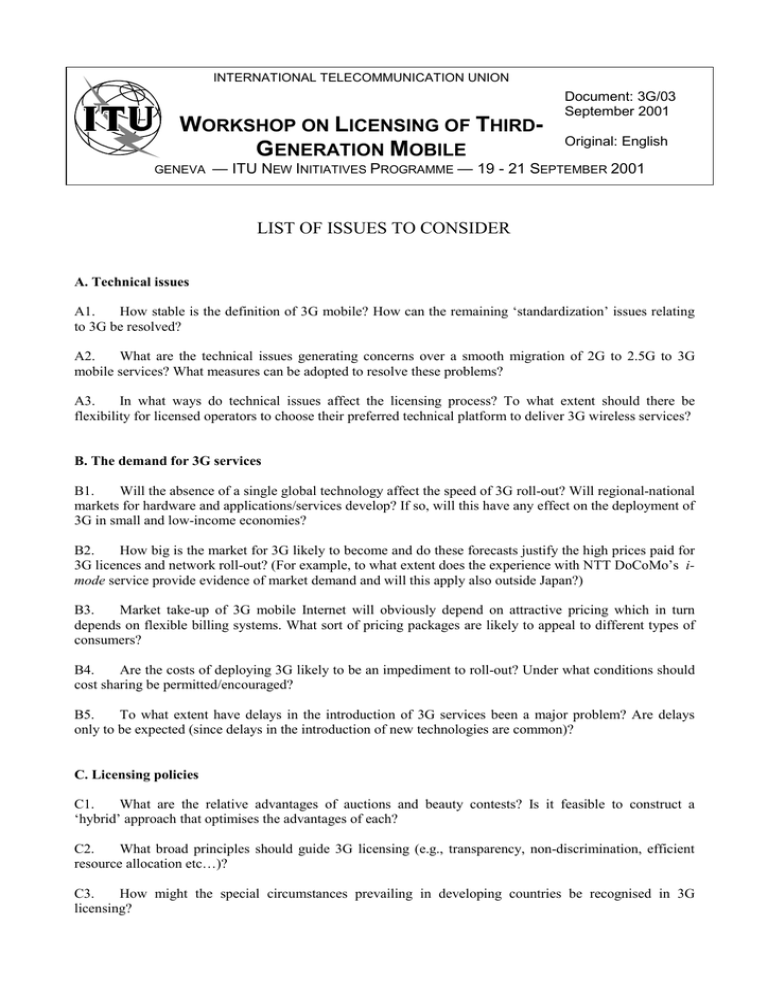
INTERNATIONAL TELECOMMUNICATION UNION WORKSHOP ON LICENSING OF THIRDGENERATION MOBILE GENEVA Document: 3G/03 September 2001 Original: English — ITU NEW INITIATIVES PROGRAMME — 19 - 21 SEPTEMBER 2001 LIST OF ISSUES TO CONSIDER A. Technical issues A1. How stable is the definition of 3G mobile? How can the remaining ‘standardization’ issues relating to 3G be resolved? A2. What are the technical issues generating concerns over a smooth migration of 2G to 2.5G to 3G mobile services? What measures can be adopted to resolve these problems? A3. In what ways do technical issues affect the licensing process? To what extent should there be flexibility for licensed operators to choose their preferred technical platform to deliver 3G wireless services? B. The demand for 3G services B1. Will the absence of a single global technology affect the speed of 3G roll-out? Will regional-national markets for hardware and applications/services develop? If so, will this have any effect on the deployment of 3G in small and low-income economies? B2. How big is the market for 3G likely to become and do these forecasts justify the high prices paid for 3G licences and network roll-out? (For example, to what extent does the experience with NTT DoCoMo’s imode service provide evidence of market demand and will this apply also outside Japan?) B3. Market take-up of 3G mobile Internet will obviously depend on attractive pricing which in turn depends on flexible billing systems. What sort of pricing packages are likely to appeal to different types of consumers? B4. Are the costs of deploying 3G likely to be an impediment to roll-out? Under what conditions should cost sharing be permitted/encouraged? B5. To what extent have delays in the introduction of 3G services been a major problem? Are delays only to be expected (since delays in the introduction of new technologies are common)? C. Licensing policies C1. What are the relative advantages of auctions and beauty contests? Is it feasible to construct a ‘hybrid’ approach that optimises the advantages of each? C2. What broad principles should guide 3G licensing (e.g., transparency, non-discrimination, efficient resource allocation etc…)? C3. How might the special circumstances prevailing in developing countries be recognised in 3G licensing? C4. What sort of obligations might be placed on 3G licensees (e.g, network deployment, social obligations, environmental obligations etc)? How should possible delays in deployment be handled by regulators? C5. Do the potential gains of infrastructure sharing exceed its costs? What conditions should be met in order to help ensure that the gains of infrastructure sharing are maximised and costs minimised? C6. Should spectrum trading be permitted? Under what conditions? C7. How should radio spectrum left unused after the first round of issuing 3G licences be dealt with? What factors should determine the organization of subsequent licensing rounds (e.g. in order to assign the additional radio spectrum identified at WRC-2000 for IMT-2000 applications; additional spectrum will be needed between 2005 and 2010 to accommodate the expected increase of the 3G traffic)? C8. Should national and international roaming be part of a 3G licence condition or left to market conditions? What further regulatory safeguards are necessary to ensure terms and conditions that allow effective and affordable roaming? C9. Given that is quite likely that existing incumbent carriers will gain control of licenses to be granted, should one or more of those license be reserved for new entrants? If yes, under what conditions? D. Enhancing the competitive landscape D1. What regulatory provision should be made for resale of 3G services and network capacity? D2. Should access by Mobile Virtual Network Operators (MVNOs) to 3G networks be inscribed as a license condition (as in Hong Kong) or left to the market? D3. Under what conditions should infrastructure sharing be permitted/encouraged? D4. What are the implications of 3G mobile Internet for interconnection arrangements? Is this an area for regulatory intervention? D5. In what ways will the different usage patterns engendered by the use of 3G mobile handsets for voice, information retrieval, as well as messaging require changes from today’s regime for interconnection arrangements, for instance to accommodate “always on” connections? D6. What characteristics in the licensing of 3G mobile operators are likely to contribute to a reduction in interconnection rates and retail tariffs? E. Globalising 3G and the role of international agencies E1. What measures can be adopted to address impediments to international roaming? E2. What measures can be adopted to facilitate the global circulation of IMT-2000 terminals? E3. In what areas would closer international co-ordination help in resolving the regulatory and economic issues raised by 3G mobile services? What roles are international agencies/organisations playing? What roles should they be playing? E4. What role, if any, should the ITU play in regard to the regulatory and economic issues raised by 3G mobile service? E5. Is there a role for the ITU in efforts to resolve 3G issues of an international nature, including interconnection disputes, roaming, and global circulation of 3G terminals?
